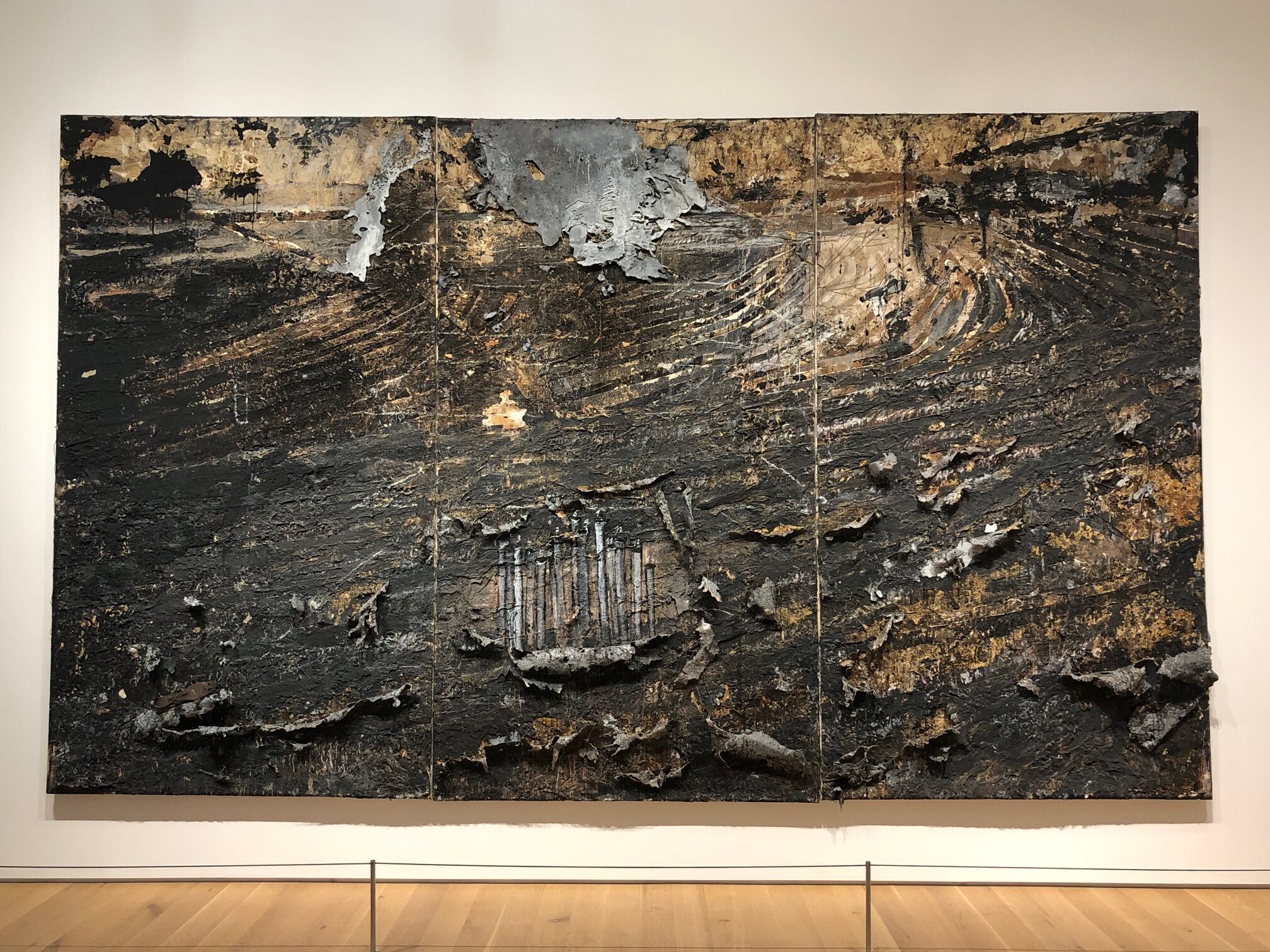
Anselm Kiefer’s Burning Rods, on display in Gallery 251 at the Saint Louis Art Museum. (Ben Fulton)
Of all the works currently on display at the Saint Louis Art Museum we can be surest that Anselm Kiefer’s Burning Rods will never be printed for postcards in the museum’s gift shops.
A massive painting that stands about 11 feet high and stretches just beyond 18 feet wide, this dark vortex of shellac on canvas, oil and acrylic emulsion, and lashed with lead, copper wire, straw, and iron, is proof that you can have nightmares while wide awake. Created between 1984-87, it is the sort of work art aficionados could easily lose their heads over in a struggle to produce the right adjectives and descriptions. For my part, Burning Rods is a portrait of destruction’s dimensions transfixed.
Even in the museum’s Gallery 251 of postwar German art that shares the room with equally imposing works by modern master Gerhard Richter—including the massive diptych November (1989), and accompanying panels December (1989) and January (1989)—Kiefer’s work wins longer gazes. Should you find beauty within its imposing textures—and it can happen, depending on your mood, and upon repeated visits—it begs the question, “How much irony can your mind hold, or possibly withstand?” Should you find it repulsive, it asks if you might be blind to awe, scale, and the mysteries of artistic creation.
Long regarded as among the top-ten (or at least among the top-twenty) living artists of our time Kiefer, now seventy-eight years old, is having a moment. Already the subject of one documentary film, Sophie Fiennes’s 2011 film Over Your Cities Grass Will Grow, he was most recently memorialized again last year by director Wim Wenders in a 3D incarnation titled Anselm, which screened for a short time at St. Louis’s Hi-Pointe Theatre earlier this year before disappearing from grasp. The disappointment of having missed seeing Anselm on the big screen lifts upon remembering that Burning Rods still hangs in St. Louis, waiting to turn my conscience to glittering ash all over again.
Kiefer’s career is one of the longest games in contemporary art in which his artistic media and visual style do not evolve so much as grow deeper, richer, and slightly more varied along his chosen spectrum of light and dark. He is a maestro of what critics have called “the artist-as-destroyer” school of artistic vision. Born in 1945, Kiefer played against the cultural identity of what it meant to be German in the wake of National Socialism’s crimes against humanity and its massive, self-inflicted wounds. Presented with water, he thought of flooding. Standing before an open field, he saw it scorched or burning. Confronted with wood, he found ways to chemically petrify it. Early in his career, Kiefer assembled books of images and charcoal drawings. In mid-career, he became fixated on various forms of horizons, and the transformation of some of the ominous landmarks of German fascism long destroyed. Later, as a full-fledged artistic lion in winter, he presided over an 86-acre studio-estate, called La Ribaute, in Barjac, southern France. There he created industrial-scale works and “on-site” installations from such heavily milked materials as broken glass, concrete, iron, and left-over shipping containers. Tunnels, subterranean rooms, vast empty halls, and mazes extend everywhere like the archaeology of the future.
“The Bible constantly says everything will be destroyed,” Kiefer intones in the middle of Fiennes’s 2011 documentary portrait. There is no reason not to agree with this paraphrase of Scripture. A cursory glance at a fraction of his oeuvre reveals a sensibility consumed with a general vibe about The End of the World. We can say the same for Burning Rods, with its reference to the cooling rods of the failed nuclear reactor at Chernobyl (visible at the middle bottom), but also the death into fourteen pieces of the Egyptian god Osiris before his resurrection by Isis, who pieced him back together.
Gazing at Kiefer’s work one afternoon this month, a group of teenagers stopped to gasp before it in brief wonder. “It’s volcanic,” said one. “It looks like a barbecue grill gone really, really wrong,” testified another.
Caught between their observations, it struck me that humor in the face of depictions as seemingly bleak as Kiefer’s is not far off the mark. There is no punchline in Burning Rods. Look carefully enough, though, and it is clear there is no distinct vanishing point, either. Its sweeping rows of cindered lines veer toward the right, then swerve into a horizon that, although rusted, also holds the promise of a subtle, yet discernable dawn. Destruction is the ultimate destination of all creation, as Kiefer reminds us. But that does not mean there are no visions to search for, and even enjoy, along the way.
